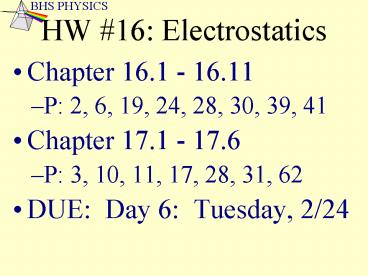HW PowerPoint PPT Presentation
1 / 50
Title: HW
1
HW 16 Electrostatics
- Chapter 16.1 - 16.11
- P 2, 6, 19, 24, 28, 30, 39, 41
- Chapter 17.1 - 17.6
- P 3, 10, 11, 17, 28, 31, 62
- DUE Day 6 Tuesday, 2/24
2
Electrostatics
- The study of stationary charges
- elementary charges
- proton ()
- electron (-)
- Units of Charge
- Coulomb (C)
- 1 C 6.25 x1018 elem ch (e)
- 1 elem charge (e) 1.60 x10-19 C
3
Charges of Objects
Conservation of Charge
- All objects carry charges
- Balance of e and p determines net charge
Negative
Neutral
Positive
4
Electroscope
- Charge Detector
Neutral
Charged
More charge
5
Charge Indicator
Even distribution
Uneven distribution
6
Charge Indicator
Even distribution charged
Polarized charged
7
Charging Methods
- Conduction contact
Charge Transfer
Charged
8
Charging Methods
- Induction indirect
ground
Charge Escapes
Charged
9
Electrophorous
- Charging Device
insulated handle
metal disk
take ground away
insulator
10
Coulombs Law
- Force between Charges
Q2
Q1
Fe1 -Fe2
Fe2
Fe1
Fe a Q1
Fe a Q2
Fe a 1/r 2
11
Coulombs Law
- Force between unlike Charges
Fe1 -Fe2
Q2
-Q1
Fe2
Fe1
Fe a Q1
Fe a Q2
Fe a 1/r 2
12
Coulombs Law
- Force between Charges
k
Fe Q1 Q2
r 2
k electrostatic constant
k 9.0 x109 Nm2/C2
13
Electric vs Gravitational
- Force Comparison
k electrostatic constant
G gravitational constant
14
Electric vs Gravitational
- Field Comparison
Fe /q
Fg / m
g
g gravitational field
g force / mass (N/kg)
E electric field
E force / charge (N/C)
15
Gravitational Field
- Point Mass
g
P
r
M
g direction same as direction of force on a mass
at point P
16
Electric Field (E)
- Positive Point Charge
P
E
Q
r
E direction same as direction of force on a
positive charge
17
Electric Field (E)
- Negative Point Charge
E
P
-Q
r
E direction same as direction of force on a
positive charge
18
Electric Field LinesRULES
- lines begin at the and end at the -
- lines never cross
- concentration of lines a field strength
- lines perpendicular to surface
- all charge is on surface
- no field lines inside a conductor
19
Electric Field Map
- Positive Point Charge
field lines in direction of force
on positive charge
Q
20
(No Transcript)
21
(No Transcript)
22
(No Transcript)
23
(No Transcript)
24
(No Transcript)
25
(No Transcript)
26
(No Transcript)
27
Electric Field Map
- Negative Sphere
-Q
28
Electric Field Map
-
29
Electric Field Map
30
Electric Field Map
- Parallel Plates
Uniform Field
net force same
- - - - - - - - - - - - -
-
31
Electric Field Map
- Lines of Force
Uniform Field
- - - - - - - - - - - - -
-
32
Electric vs Gravitational
- Potential Energy Comparison
PEg work to lift mass in a uniform
gravitational field
PEe work to lift charge in a uniform
electric field
33
Potential Difference
- Voltage (DV)
DV Energy Charge
DV energy per unit of charge
Volt Joule / Coulomb
Energy DV (Charge) DV q
34
Electrical Energy
E DVq
1 C
1 C of charge lifted to the top of a 1 volt
hill stores 1 Joule of energy
1V
1 elem charge through a 1 volt potential stores
1 electronvolt (eV) of energy
1 e
1V
1 eV 1.6 E-19 Joules
35
Potential Difference
- Voltage (DV)
DV Energy Charge
q
DV E Dd
E is constant
36
A Different Look atElectric Fields
DV
E
Dd
Electric Field Gradient (V/m)
Electrical topography
37
Electric Field
- Two ways to think about it
DV /Dd
Fe /q
(V/m)
(N/C)
38
Gravitational Field
- Two ways to think about it
accel.
Fe /m
(m/s2)
(N/kg)
kg
39
Electric Field Map
- Equipotential Lines
Topographic Lines
Connect points of voltage
10 V
8V
6V
4V
2V
- - - - - - - - - - - - -
-
0 V
40
Electric Field Map
- Equipotentials (Contour Lines)
Q
41
Electric Field Map
-
42
Electric Field Map
43
Sample Question
- Given DV, d, mass charge of electron
- Find Fe, accel of electron
- Mass 9.1 e-31kg, charge 1.6 e-19C
Fe gtgtgtgtFg
E 2000 V/m
F e 3.2 e-16N
-
electron
a F/m
F g 9.1 e-30N
F ma
a 3.5 e 14 m/s
- - - - - - - - - - - - -
-
44
Millikan Oil Drop Experiment
- Quantify the charge of electron
a 0
v 0
F e
net force 0
oil drop
F e F g
E q mg
F g
q mgd /DV
- - - - - - - - - - - - -
-
45
Millikan Oil Drop
unit check
q mgd /DV
C kg N m
J
C
kg V
J/C
46
Millikan Sample Question
- Given DV, d, Weight of drop
- Find E, Fe, Fg, q drop, e on drop
E F/q
F e
E DV/d
-
oil drop
F g 2.8x10-14
E 3500V/m
E 3500N/C
- - - - - - - - - - - - -
-
47
Millikan Sample Question
- continued
Fe F g 2.8x10-14
Eq mg
q mg
(2.8x10-14N)(.1m) 350 V
(8x10-19C)
)
(
1 elem ch
e
(8x10-19C)
5
(1.6x10-19C)
48
Absolute Electrical Potential (V)
r
P
Q
V /- kQ
r
49
Absolute Electrical Potential
Q1
Q2
P
r1
r2
r3
V /- kQ
r
Q3
Vp V1 V2 V3
50
Electric vs Gravitational
- Absolute Potential Energy Comparison
k
Ug - M1 M2
G
Ue /- Q1 Q2
r
r
Ug always negative
Ue positive or negative

